Affiliate links on Android Authority may earn us a commission. Learn more.
The Watch just made Apple over $1 billion. Why hasn't Android Wear been as successful?
Published onJuly 24, 2015
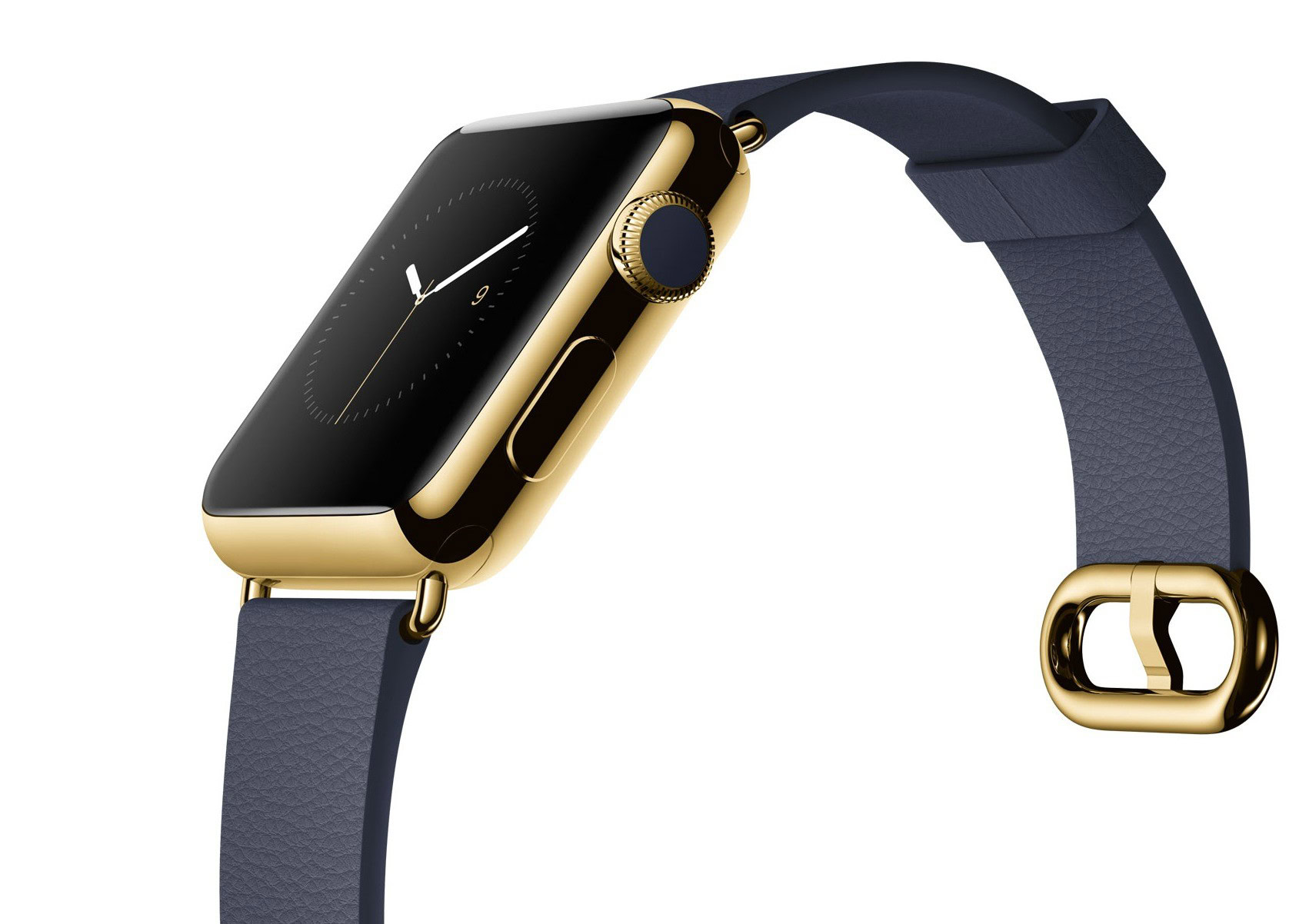
It’s official: Apple has a license to print money. In what may be the most unprecedented financial return ever for a new product category, the company’s quarterly guidance report has numerous analysts concluding it may have sold over $1 billion worth of Apple Watch devices in the three months the wearable has been on sale.
Despite what some might call success, the figure is ironically well below the almost $2 billion+ that some had expected, a issue that was likely fostered by supply shortages or long waits. Still, this approximated figure means the wearable earned more money than either the iPad did, or the original iPhone, when they first launched.
The earnings come at a period of absolute prosperity for Apple, which for Q1 2015 reported the most profitable financial earnings in history for a publicly traded company. More recently, The Wall Street Journal published a piece that took a deeper look into those results and found that, while Apple sells only 20% of the world’s smartphones, in Q1 2015, it managed to earn 92% of the profits.
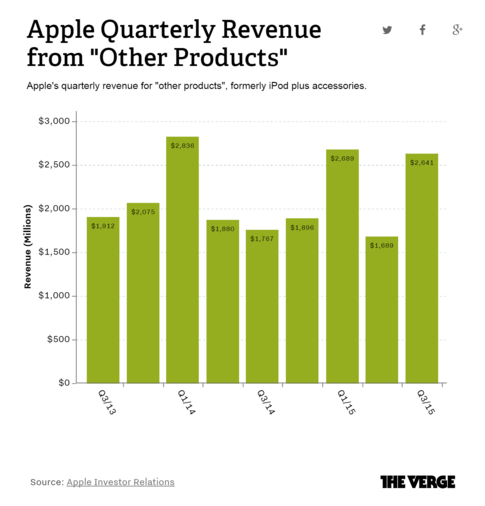
All about Apple (and Google)
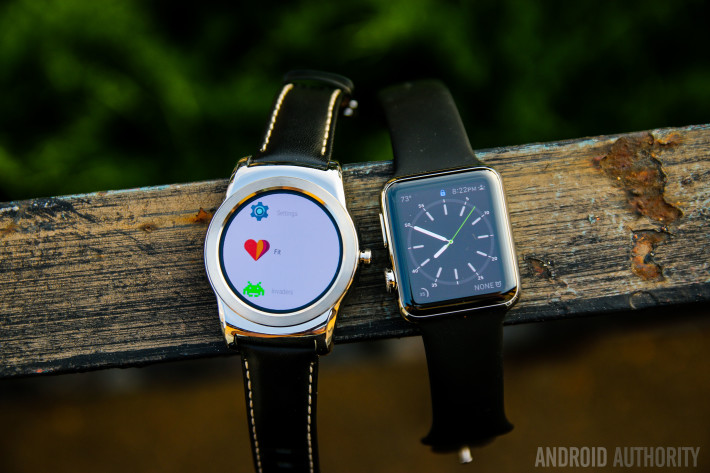
Apple itself is not giving specifics. The figure everyone is throwing around has been deduced from reported earnings on “Other Products” sold, and assumes there was no growth with respect to iPod, Beats, or other items. Additionally, because Apple has deliberately chosen not to provide any information about which models of the Apple Watch sold what numbers, we can only speculate. For reference, some had initially predicted the wearable would have sold 3 or 4 million units by this point.
For the sake of argument, if Apple sold nothing but Watch Sport devices (each roughly $400), that would mean approximately 2.5 million units were sold. In reality there are countless factors involved given that the device comes in two sizes (each having a slightly different price) and arguably the more desirable of the “cheaper” two versions (“Apple Watch”) does, itself, come in several different band offerings that separate the price in terms of hundreds of dollars. And then of course the Apple Watch Edition is present, for those customers which ASUS has determined must be insane.
For the sake of argument, if Apple sold nothing but Watch Sport devices, that would be approximately 2,500,000 units, far FAR more than the meager 750,000 Android Wear saw in all of 2014.
For the sake of this piece, and for the sentiment it seeks to share on the whole, it ultimately doesn’t matter how many of which model Apple sold. Any way you run the figures, Tim Cook & Co. have indisputably eclipsed the roughly 720,000 Android Wear devices that estimates say Google managed to ship in all of 2015. For reference, Android Wear launched on June 25th, which means that figure takes into account 6 months and six different products: the Samsung Gear Live, the LG G Watch, the Sony Smartwartch 3, the Motorola Moto 360, the ASUS ZenWatch, and the LG G Watch R. And Samsung’s Tizen-based Gear S for reference? First day sales were just 10,000 units whereas Apple managed to net over 1,000,000 for its Watch on the first day of pre-orders, a number that didn’t even take into account non-US based figures.
[related_videos title=”Android Wear” align=”center” type=”custom” videos=”613281,608623,594467,591854,579535,575096″]
Apple’s offensive
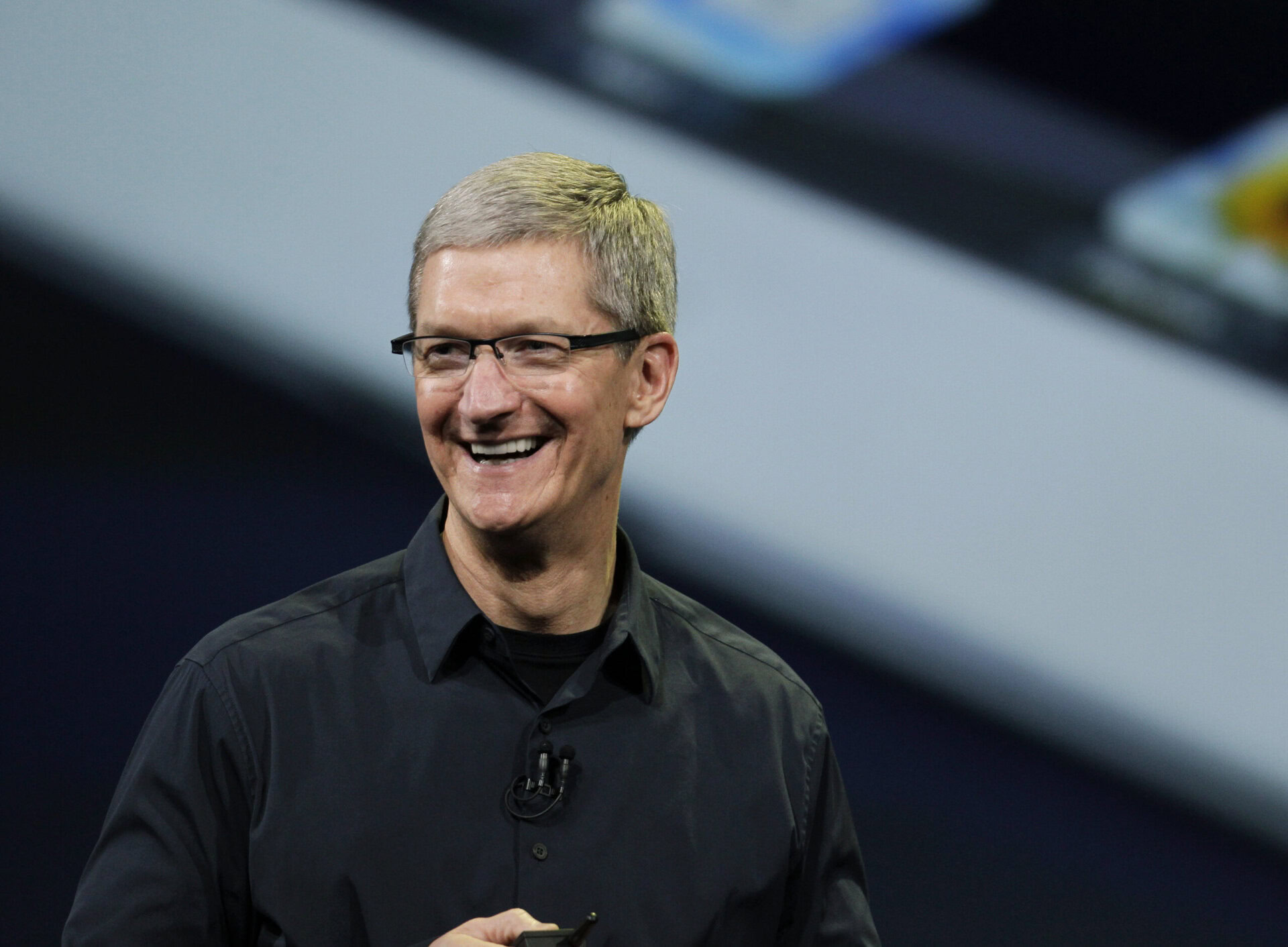
To understand why the Apple Watch has been seemingly so successful, naturally it has less to do with the product itself than it does the lifestyle it represents. To understand the sentiment, one need only to look at the endless number of professional reviews of the Apple Watch, very few of which were actually glowing or implying the device – as it stands today – is somehow going to change one’s existence. Even with a novel user interface and creative use of the “digital crown” to achieve zoom functionality, there is very little the Apple Watch does that existing Android-compatible products didn’t already offer. Granted as more apps become available this has the potential to change, as it does with software updates, but looking at even Samsung’s Tizen-based Gear S, it has several novel features that are impossible on the Apple Watch, the most obvious being SIM card support.
Apple sold its Watch in no small part because its user base responds well to marketing, to cachet, to social factors, and to image. As is often argued, Apple customers tend to have more money, or are willing to spend more of it, hence the large profits the company enjoys and greater app-generated revenue than Google’s Android. These customers are more likely to want to show off their new trinket, and more likely to want it to begin with even if they don’t know how or why they would use it. Apple is, in a sense, “cool”, and most everyone wants to be cool. Apple esentially found a way to get people to buy a time piece for wrist, even when their phone already serves the same purpose.
Google’s main problem is… Google
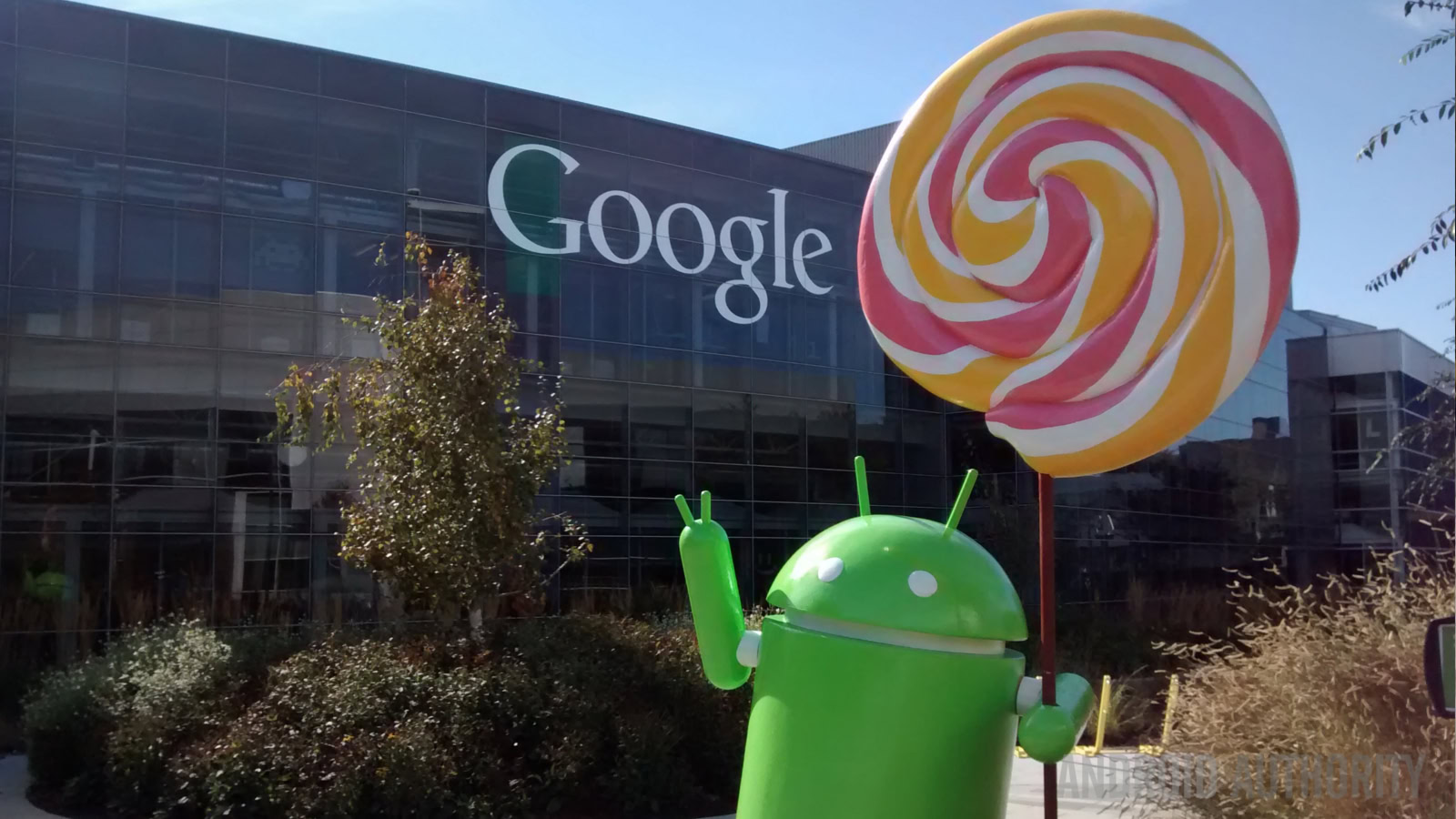
Indeed the problem here, if one exists, is really one of Google’s subdued, almost apathetic consideration of the wearable market as a whole. Given how much brouhaha was made about Glass when it was first announced, it’s all the more surprising, though it’s also likely the ultimate fate of the expensive wearable also served as a wake up call: general consumer interest is hardly present at best, and even among the more tech-oriented price is still a factor for a product that is still “unfinished.” These days, talk of its successor refer to a product that will have a much more niche, much more focused use rather than the mainstream consumer device that was once envisioned.
When Android first stepped into the market, arguably the biggest need Google had was getting vendors and OEMs alike to accept the fledgling OS while the world was smitten with a certain Cupertino-cropped crop. Android has certainly taken off, but the same can not be said about Android Wear, a platform that has seen substantial improvements in the year since its release, yet severely lacks the momentum and attention that Apple has garnished. Google has, in a sense, failed to “sell” the idea that consumers need to wear a watch to complete their lives whereas Apple has.
There are many reasons for such a conundrum, though arguably decisions to lock down the wearable OS in a manner (and fashion) that couldn’t be further from the mainstay Android device ecosystem is certainly at the top of the list.
Instead of allowing for choice and creativity, Google has opted for a divisive strategy not unlike that which Microsoft attempted with Windows Phone 7. WP7 phones were unable to include things such as fast CPUs, or even large or high resolution displays, a feature that wasn’t added until Windows Phone 8 Update 3. One of the core mistakes Microsoft eventually realized was that it couldn’t keep up the charade, and one need only look at the non-existent line-up of Windows Phone 10 launch devices to see what’s become of this sordid situation.
The man with the iron fist

Perhaps the largest reason Android Wear has truly failed to excite or take off with the mainstream is due to the way Google has exerted complete control over its functionality and form. No cameras. No cellular modems. No modifications. You can literally buy any random Android Wear product and be met with the same experience across the board.
What’s the end result then? Maybe one has a few extra watch faces. That’s about the limit to which OEMs can “work their magic” and instead are confronted with making the most out of the outside. First we had square faces, now round is sound. But just how different does the HUAWEI Watch actually look from the LG Watch Urbane? There are only so many ways you can make a watch, and due to the way Google has stymied development the choices are even fewer.
The point really hits home when taking a look at just why it is customers needs are better met when there are choices. If someone wants a smartphone with a great camera, Sony is usually mentioned among the top choices. If someone wants a smartphone with a beautiful, vibrant display, Samsung is usually the first choice. If someone wants a low price, perhaps HUAWEI or ZTE. With the sheer diversity among Android devices, there is truly something for everyone. With Android Wear however, there is not.
Variety is the zest that’s missing
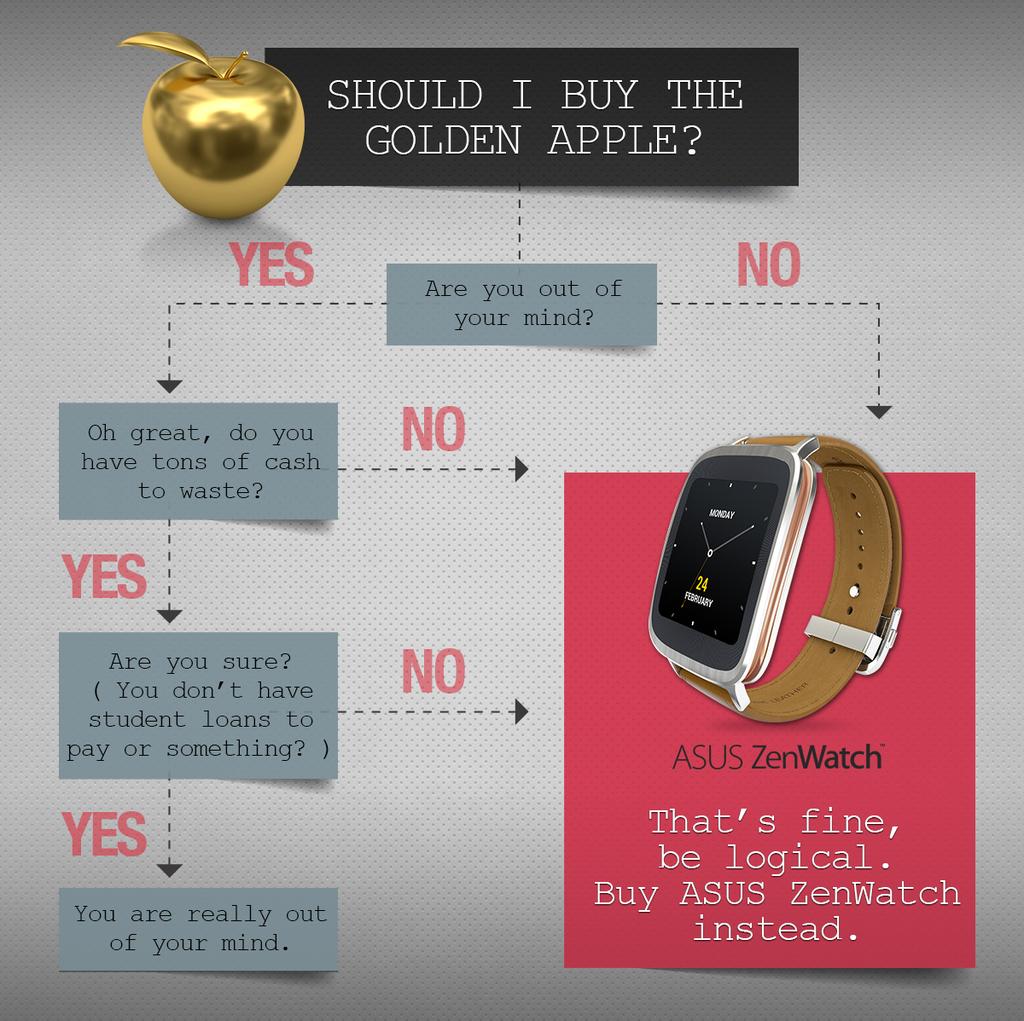
Those customers who want to make calls on their wrist a la Dick Tracy must run to Samsung. People who want a robust fitness experience might look to Fitbit. And what about design; time pieces are all about design, and what then, for those customers on Android who do have cash to burn, and who would be willing to pay “Apple Watch money”? Well at the moment, they are flat out of luck. This is truly bizarre when considering just how outlandish some of the Android devices of the past have been: Google the company that once encouraged thinking outside the box is now living in it?
With the sheer diversity among Android devices, there is truly something for everyone. With Android Wear however, there is not.
It makes sense why a company like Samsung has made dedicated efforts to provide Gear wearables that offer experiences which can not be had with Android Wear. Take the Gear Fit, which has a curved, rectangular display. Doesn’t meet Google’s requirements. What about the Gear S which has an embedded cellular antenna for voice calls? No go for Android Wear. And what of its upcoming Gear A, once known as “Project Orbis“? It’s allegedly going to use a ring-based navigational system and that is definitely not kosher with Google.
Still, trouble is abound when you look around: to date Samsung has six different Gear Watches, only one of which uses Android Wear. LG has three that support it, but has already released the Urbane LTE which runs WebOS instead, and has far more form and functionality with three working hard buttons on the side and an embedded cellular radio. Perhaps most importantly, it doesn’t require formatting the device to pair it with another phone. Are these devices making a killing? Obviously not, but they indicate their respective OEMs are willing to make concerted efforts to break out of Google’s shadow.
Price competition
Another issue to consider is that of Android at-large, namely the lack of profitability for basically anyone but Samsung and Google itself:
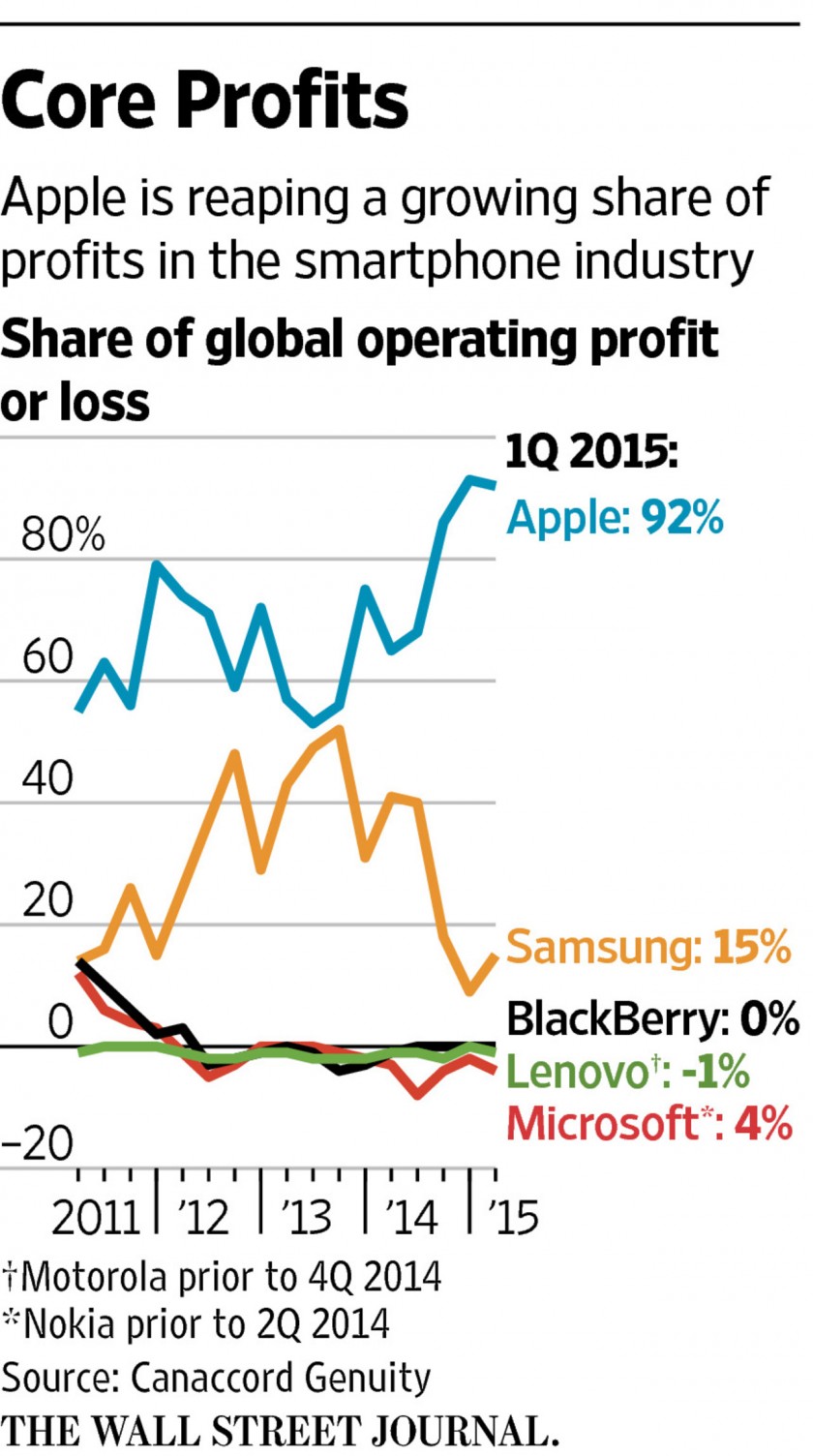
As mentioned earlier in this piece, and as covered last week, Apple is the undisputed winner when it comes to earning money. Despite selling just 20% of the world’s smartphones in Q1 of this year, it managed to capture 92% of the profits. Samsung, in turn, the largest Android OEM, had but 15% (because the research takes losses into account, the total of the shares is higher than 100%).
Of course, there is a company who is making cash hand-over-fist with Android: Google. Every single one of the billions of Android products in the market that have access to Google Play Services means that Google earns money from ad revenue and data mining framework. Of course Android OEMs are keen on using the OS because it alleviates them from having to create their own mobile OS and fuss around with developers and support. Samsung is no stranger to this problem, as can be readily seen with the trials and tribulations associated with its Tizen platform.
At the end of the day, this lack of profits means potentially less resources to actually develop and release Android Wear devices. HTCfor example, has been having financial troubles off-and-on for years now, and the fact that budget-friendly products are selling so well means it will continue to in the future. If said company is having enough trouble as is selling flagships like the One M9, where is it supposed to find the cash to spare on a wrist-worn-wearable? The sheer amount of money needed for a project like this, even on a small budget, is immense: the R&D costs, the labor costs, the manufacturing costs, the marketing costs… when dealing with products that are aimed at developed countries and markets where you have Apple or Samsung to contend with, it’s just not possible to go small, you just don’t go at all.
Fragmentation, perhaps in part
To an extent, the tired-and-true claim of fragmentation can be addressed, though the true nature of its fostering this situation is arguably a small one at best. Android Wear is only compatible with Jelly Bean 4.3 and up, and unfortunately there is still a large minority of the population that is unable to use it, even if they wanted to. Consider the following:
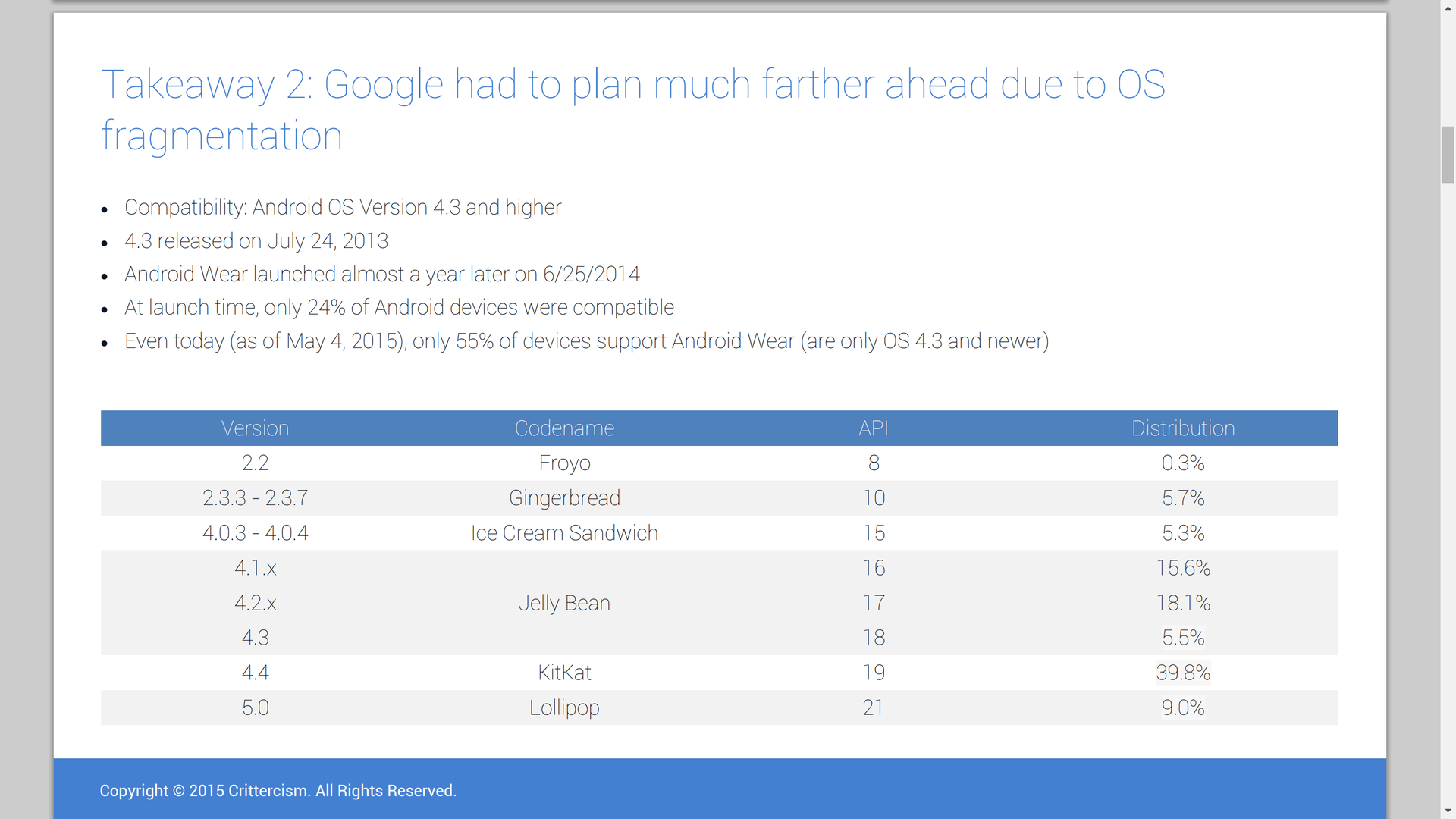
As added emphasis, consider this as well:
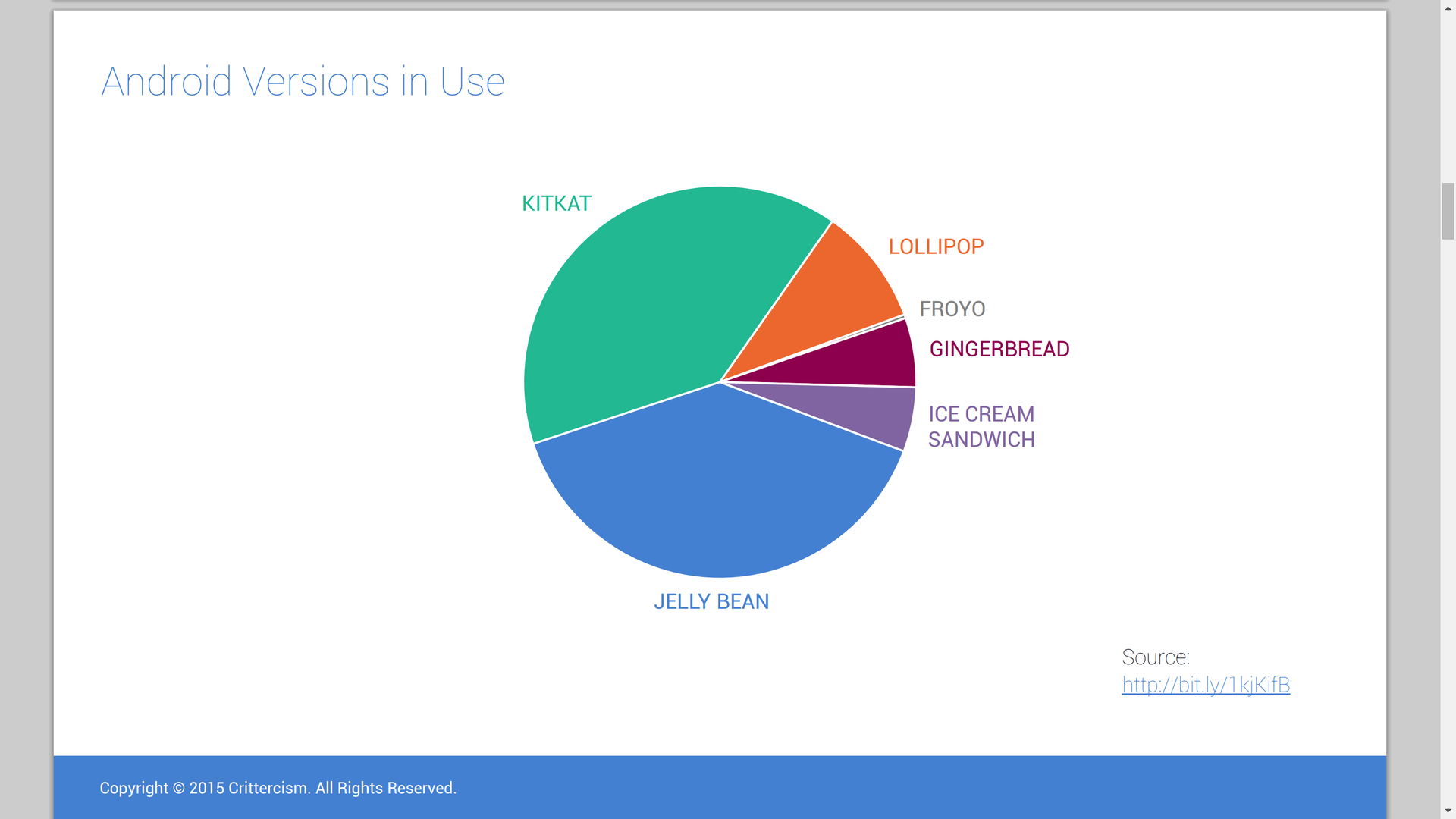
Android Jelly Bean (4.3) launched on July 24, 2013 and it – or any build released after – is required for Android Wear compatibility. As the first visual mentions, at the time of the wearable platform’s launch on June 25, 2014, “only 24% of Android devices were compatible”. This is a major limiting factor, especially when compared to the 50% of iOS phones that were compatible a week before Apple Watch hit stores.
The second visual would serve to indicate Jelly Bean itself is running on almost half of all Android smartphones, but with respect to Android Wear the situation is more complicated. Jelly Bean was the name given to three different builds: 4.1, 4.2, and 4.3, and as the first visual indicates, 33.7% of JB’s 39.2% share is not compatible. When you combine this with percentages running even earlier versions of Android, you arrive at 45%. Of the billions of devices running Android in the world today, 45% of them can not, and arguably will never be able to, run Android Wear. In the case of Gingerbread in particular, it has been almost half a decade since the OS became outdated yet lo and behold 5.7% of the world is still using it.
While it is easy to argue that customers who want wearables would be the same ones who have the latest-and-greatest devices at all times, this is not necessarily the case. Consider the situation with the LG G Flex and Japan, for example, wherein the one carrier that sold it, KDDI au, utterly failed to update the device past Android 4.2 despite LG itself having long since made 4.4 KitKat available for the model elsewhere. Thus for anyone who bought this phone, which released about less than 18 months ago, they are squat out of luck. Consider this situation on a global scale and it becomes quite clear just why so many devices are still running pre-4.3 builds of Android.
Going back to the Microsoft/Windows parallel discussed earlier, this parrots the very same conundrum that existed with Windows 8’s native “Metro” apps: There was, and has never been, any incentive for developers to make “Modern UI” programs simply because only those running Windows 8 or 8.1 can even use them. What’s the point when the vast majority of the world is still on Windows 7, XP, or even Vista? This is arguably the exact reason Apple has never deemed it worthwhile to make a “modern” iTunes.
Let’s reason it out
While it’s easy to attack Google for “heavy-handedly” managing Android Wear, there are a number of very clear reasons why it has chosen to.
Fragmentation
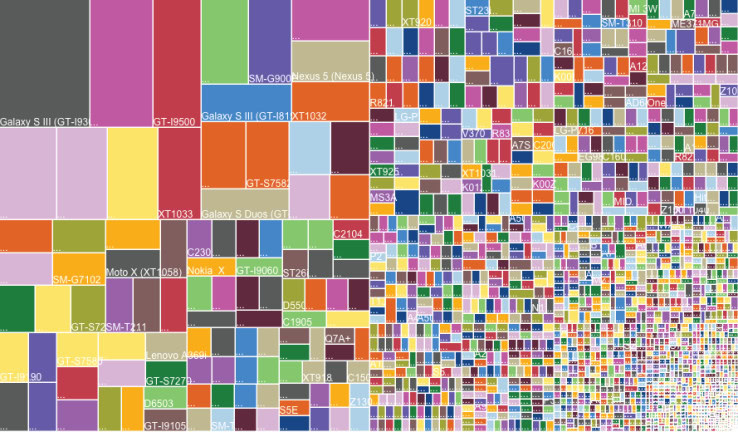
Arguably the largest reason Google doesn’t want Android Wear to be an open free-for-all lies in the very nature of what Android-proper is: a teeming, tangled mess of fragmentation, though ironically almost none of it is Google’s doing. The very core of Android’s existence allowed for companies like Samsung, HTC, LG or Motorola to skin everything in the old days. It is the issue that allows the new wave of OEMs, HUAWEI, Xiaomi, OPPO and others to continue to “mess with” the user experience even now, as companies like Samsung finally got the hint.
By holding the keys to the castle, Google is able to exercise total control over what goes on in its courtyard, and in doing so can make sure that certain standards are adhered to. While Google has more recently taken to moving functionality to the Play Services framework, instead of relying on OS updates – which may never come depending on the OEM – the same can’t be said about third party developers. Truth be told it is a major burden for software engineers, to manually check each and every build and possible configuration of Android to ensure their software will work on the device of your choice. This has become even more pronounced given that budget products might still be running on Jelly Bean, Ice Cream Sandwich, or even Gingerbread.
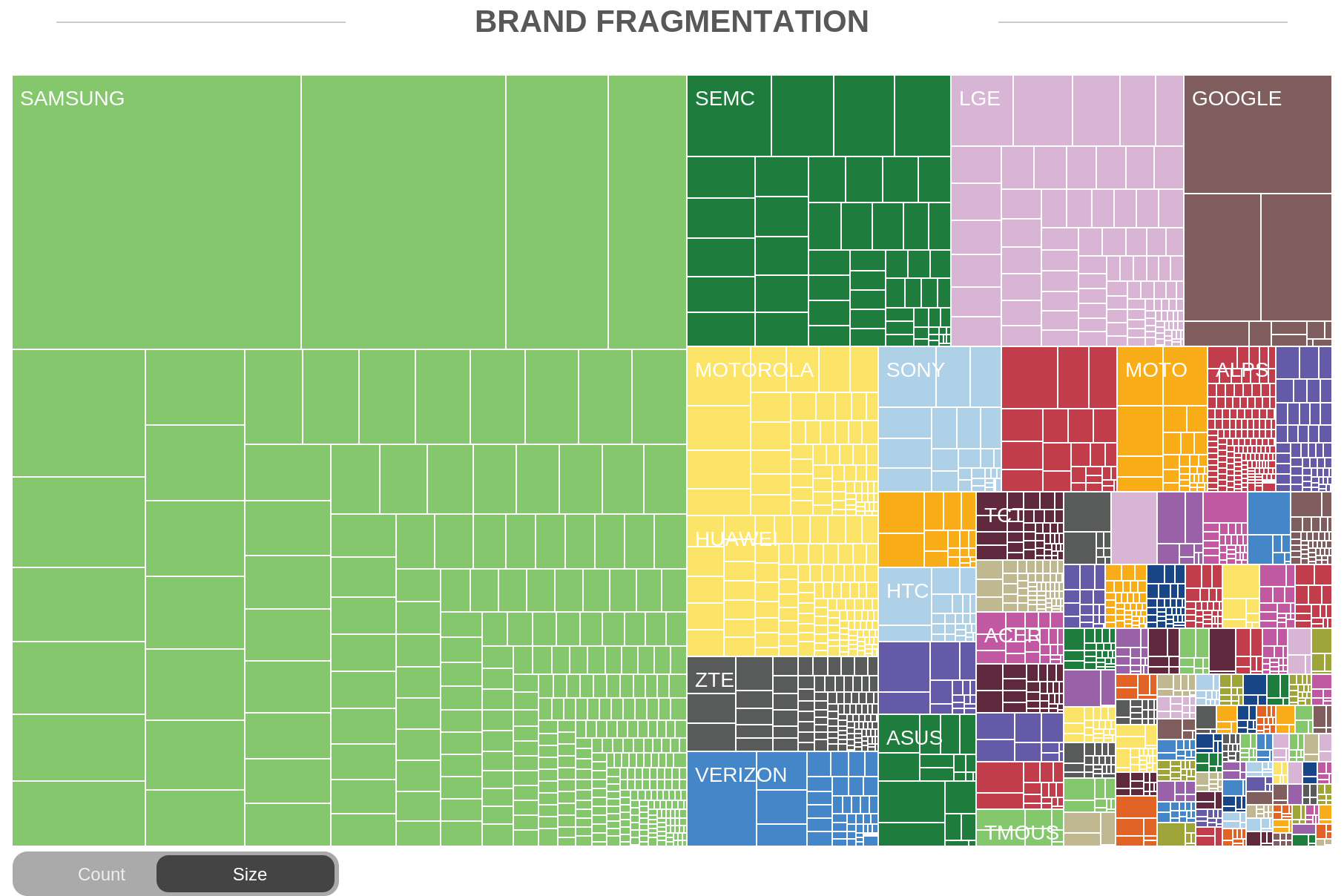
By locking down Android Wear to Google’s Android and not AOSP, it also ensures that all wearables make full use of Google Play Services, something that cannot be said of smartphones released in China. Android Wear is heavily dependent on Google Now, and thus by requiring KitKat, it thereby ensures all compatible handsets will support it.
China trouble
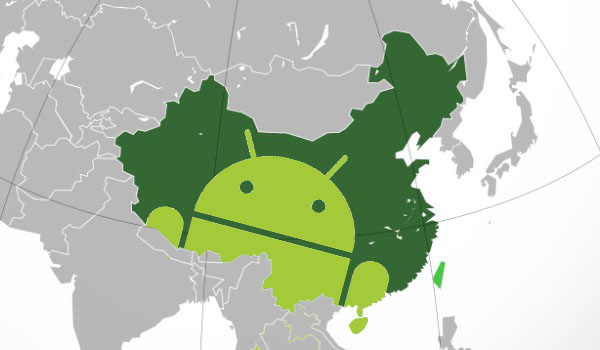
The very fact that Google Play Services are still banned in China is another reason to lock down Android Wear. As we saw with the Chinese Galaxy Note 4, products designed for China ship without Google apps installed and are unable to use any of the framework that makes them run. Of course there are ways around this, but for the general public who will never miss their presence, it only furthers China’s agenda.
If Android Wear were to be open, and if it were to catch on in China’s rapidly expanding mobile market, it would mean that countless local OEMs could be creating products, and that is downright infuriating for Google, who is thus not able to earn any money from use of its infrastructure, services, and advertising models. China has over a billion people, and yet as things stand now, Google is – in theory – not getting a single yuan from any of them. In a sense, it would be tantamount to thousands of Kindle Fire variants. Google worked hard to create the OS, and it definitely wants to get something back in return.
Quality control
Another key benefit, Google can ensure quality control standards, even if only indirectly. Think for a moment just how many Android devices there are. Consider all the budget ones that are sold at extremely low prices. There is no guarantee of anything whatsoever. Apple, paradoxically, is able to justify it’s high price point for the Apple Watch in part because consumers trust Apple, and because Apple itself has brand value. When one considers the current crop of Android Wear offerings, they are all sold by legitimate, established companies that have their own sense of trust among consumers. Just imagine what would happen if “random brand x” were to start selling an Android Wear smartwatch.
With Android you can put the OS on everything, from a price-defiant Vertu to a bottom-barrel budget product, and the differences couldn’t be more astounding. One phone might have support for a specific sensor, yet another doesn’t. One device might have insufficient RAM to properly run its skin, yet the other has too much. Apple has never had to deal with qualms about consistency and cohesiveness with its devices, but Google (inadvertently) has. By standardizing everything and specifying the exact requirements, Google is therefore ensuring all users regardless of price or product, that the experience will be uniform. Think of it as a Starbucks that must adhere to a specific company-wide recipe for mocha coffee as opposed to hundreds of different restaurants that may blend the beverage differently.
Conclusion: mad money to be made

While Apple’s success might be good news for the folks over in Cupertino, it’s of a far more mixed blessing to those working with Android. Google’s own wearable OS has been available for over a year now, yet there is not a shred of evidence from the company’s own PR team to suggest it’s even successful.
Google is essentially taking a very careful, leisurely approach to Android Wear. This might be in part because the market for wearables is in and of itself limited in scope. It might be a result of the general consensus that Glass was a failed experiment. It might be a desire to keep things under stricter control to prevent OEMs from going crazy with the functionality. Whatever the true reason is, be it one, several, or all of the possibilities above, Google is once again going to play second fiddle to Apple, something that is decidedly uncomfortable, given that Android Wear launched almost an entire year before Apple Watch. Google should be calling the shots, not dodging the bullets.
The Bad
In one sense, Google’s wearable OS can be considered a failure as far as widespread adoption goes. Unlike its smartphone and tablet platform which has devices of all shapes, sizes, and prices from almost a thousand OEMs, Android Wear has been a platform key manufacturers have either deliberately ignored (see Samsung’s Gear S), chosen to start ignoring (see LG’s “test” device the Urbane LTE), or else ignore entirely (see HTCfor example). Meanwhile, Motorola drew attention last year with the Moto 360 but has yet to announce a followup, and HUAWEI’s eye catching offering has yet to materialize months after it was announced.
The Good
Despite the general malaise confronting Android Wear, there is a potential silver lining: if Apple can sell over $1 billion worth of smartwatches in a scant three months, there is an untold amount of money it can make within a year, or with a new, updated product. By that reasoning, Google itself, along with partner OEMs, are also poised to earn major money with Android Wear. Despite the rather humble beginnings, now that the cash cow is out in the field, one would hope that Team Android gets its act together and starts putting some serious effort into the wearable platform.
Now that we have weighed in, we want to hear from you! What’s your take on the whole Android Wear situation? Is Google doing enough? Is the wearable platform just not worth the effort? Leave your comments below!